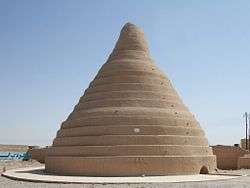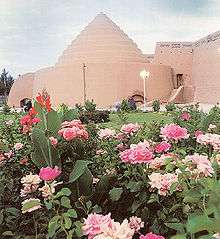Yakhchāl
Yakhchāl (Persian: یخچال "ice pit"; yakh meaning "ice" and chāl meaning "pit") is an ancient type of evaporative cooler. Above ground, the structure had a domed shape, but had a subterranean storage space. It was often used to store ice, but sometimes was used to store food as well. The subterranean space coupled with the thick heat-resistant construction material insulated the storage space year round. These structures were mainly built and used in Persia. Many that were built hundreds of years ago remain standing.[1]

_Meybod_Iran.jpg)
_Meybod_Iran.jpg)
Design and process
By 400 BCE, Persian engineers had mastered the technique of using yakhchāls to create ice in the winter and store it in the summer in the desert. In most yakhchāls, the ice is created by itself during the cold seasons of the year; the water is channeled from the qanat (Iranian aqueduct) to the yakhchāl and it freezes upon resting inside the structure. Usually a wall is also made along an east-west direction close to the yakhchāl and the water is channeled from the north side of the wall so that the shadow of the wall keeps the water cool to make it freeze more quickly. In some yakhchāls, ice is also brought in from nearby mountains for storage or to seed the icing process.
The building allows cold air to pour in from entries at the base of the structure and descend to the lowest part of the yakhchāl, large underground spaces up to 5,000 m3 (180,000 cu ft) in volume. At the same time, the tall conical shape of the building guides any remaining heat upward and outside through openings at the very top of the building, and through this active process the air inside the yakhchāl remains cooler than the outside. The yakhchāl is built of a unique water-resistant mortar called sarooj, composed of sand, clay, egg whites, lime, goat hair, and ash in specific proportions, that is resistant to heat transfer and is thought to be completely water-impenetrable.[2] This material acts as an effective insulation all year round. The sarooj walls are at least two meters thick at the base.[3]

More commonly, yakhchāls have access to a qanat, and sometimes equipped with a system of bâdgirs (ancient design of windcatchers or wind towers) that could easily bring temperatures inside the space down to frigid levels even in summer days. Built of mud or mud brick, in square or round shapes, bâdgirs catch the slightest breeze by the vents at the top and funnel the cooling air down through internal, vertically-placed wooded slats to the water or structure below. Alternately, the bâdgir can function as a chimney, expelling warm air upward to pull cool air in from a base opening or a connected qanat (the qanat air is cooled by the underground stream). Many of the homes in the desert towns are also equipped with the bâdgir system.
The ice created and stored in yakhchāl is used throughout the year especially during hot summer days for various purposes, including preservation of food, to chill treats, or to make faloodeh, the traditional Persian frozen dessert.
A yakhchāl in Kerman is located about one and a half kilometres from the centre of the city. This cone-shaped building is about eighteen metres high. The massive insulation and the continuous cooling waters that spiral down its side keep the ice frozen throughout the summer.
In present-day Iran, Afghanistan and Tajikistan, the term yakhchāl is also used to refer to modern refrigerators.
See also
- Ab Anbar – traditional Iranian water reservoir
- History of Persian domes – Part of Persian architecture
- Ice house (building) – Building used for storing ice all year round, before refrigeration
- Qanat
- Soltaniyeh
- Traditional water sources of Persian antiquity
- Windcatcher – Architectural element for creating a draft
References
- Mahdavinejad, M; Kavan Javanrudi (July 2012). "Assessment of Ancient Fridges: A Sustainable Method to Storage Ice in Hot-Arid Climates". Asian Culture and History. 4 (2). doi:10.5539/ach.v4n2p133.
- "Yakhchāls, Āb Anbārs, & Wind Catchers — Passive Cooling & Refrigeration Technologies Of Greater Iran (Persia)". CleanTechnica. 2018-04-28. Retrieved 2020-02-18.
- "یخچال ایرانی چگونه کار میکند؟ - سالارکتاب: اطلاعات معتبر و مستند". سالارکتاب: اطلاعات معتبر و مستند (in Persian). 2018-06-06. Retrieved 2018-10-03.
Further reading
- Rutstein, Harry; Kroll, Joanne (1980). In the Footsteps of Marco Polo : a Twentieth Century Odyssey. New York: Viking Press. ISBN 9780670396832. OCLC 6197014.
External Links
- Raman, Aaswath (2018-06-01). "Transcript of "How we can turn the cold of outer space into a renewable resource"". TED. Retrieved 2020-03-06. A TED talk on radiative cooling.
| Wikimedia Commons has media related to Icehouses in Iran. |
